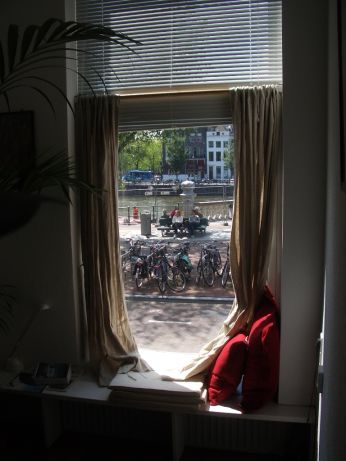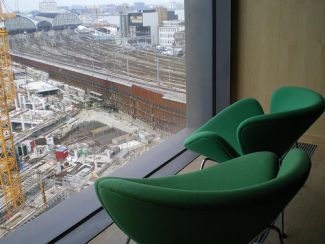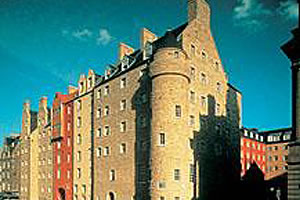I am propped in the windowsill nook at the front of our Amsterdam apartment. It has a cushioned perch for wedging oneself into and watching passers-by. I am a honey-fed housecat in a sunbeam.
For my first blog post, I want to laud the Dutch for appreciating the windowsill.
The large windows that you find on Amsterdam’s canal buildings rarely have balconies (the weather would make a proverb of them – ie. “as useless as a Dutch balcony”), but they frequently enshrine cosy windowsill nooks for propping oneself in and reading, perhaps occasionally to look up and watch the driving rain uselessly hurling itself into the canal, and put a hand or cheek to the chilly pane and be reminded of how snug you are. To this end, many Dutch windowsills have a little bench with cushions on it and possibly a radiator beneath.

Windowsill with perch
An Amsterdam canal building, although narrow, usually donates most of its façade to windows. Given typically short days and overcast Dutch skies, natural light can be a scarce commodity and catchment must be maximised. Just as the giant squid evolved enormous saucer eyes, Amsterdammers adapted to similar environmental conditions with large windows. (When I say large, I mean at least 1.5m wide – which is the ideal width for wedging a human body, perhaps one foot propped against the wall, the other dangling from the perch). The apartments within these buildings – often just a deep, narrow, high-ceilinged space (reminiscent of a ship hull, and sometimes just as dank) – can be completely dependant on a single front window for natural light.

Footnote: Rembrandt, were he alive, may wonder why art historians make such a fuss about his use of darkness in portraiture – I expect it came naturally to him and that he had an ample supply of it.

Rembrandt: Self-Portrait at Bathroom Mirror
The magnificent Amsterdam Openbare Bibliotheek contains some excellent examples of how the Dutch recognise the windowsill as a space of serenity and contemplation. The cutting-edge library, now the largest in Europe, contains many species of quiet spaces for scholars. Gone is the the standard library model of the communal Quiet Work Room (Shh!): sub-subs like myself frequent these begrudgingly, all the while grumbling under our breaths like bag-ladies about mobile phones and gossiping students. Instead there are a Bavarian castle’s worth of quirky little spaces for only one (perhaps two) sub-subs to cogitate in peace. My favourite examples make use of the library’s vast windowsills:


If you are still reading, I’ll reward you by concluding with a naughty bit. I’d like to make a thesis that the Amsterdam tradition of large windows was as much a historical antecendant to the Red Light district as any unchecked mercantilism or the so-called ‘Dutch tolerance.’ The typical Amsterdam housefront window exceeds 2m in height (and I have seen ground floor windows double that) – quite big enough for a man to stand in – hence even the common street apartment can function as a department store window for flesh mannequins. One just needs to stand in the window in one’s underwear and, voila, instant Red Light district (I did it myself, by accident, one bleary-eyed morning – to eliminate misunderstandings, add tacky lipstick-neon backlighting).

Amsterdam’s Red Light District, as we know it, with streets of sex-splattered windows like a vast vending machine, could hardly have emerged in, say, Edinburgh, where architects favoured Hobbit-esque, bathroom-sized windows set into forbigging stone battlements, and which are better suited for firing crossbows from.

Thus runs the thesis: that architecture is a causal factor in prostitution. It’s a bit like the broken window theory, but without the broken.